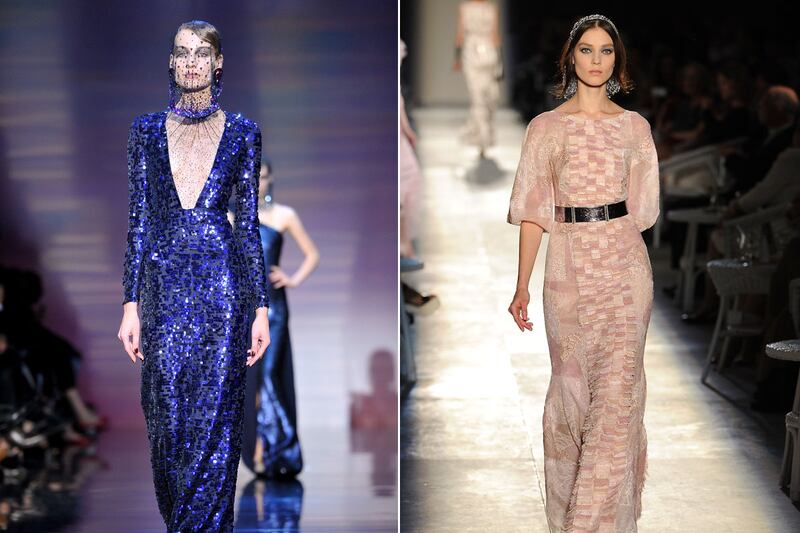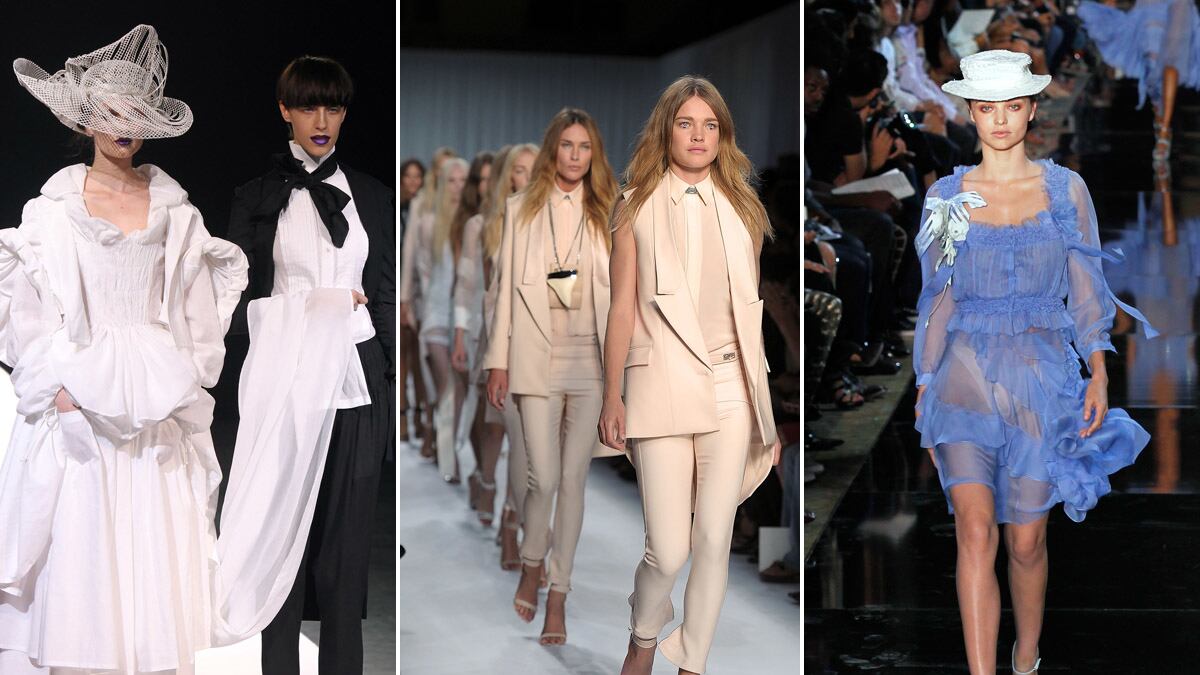The women who arrive for the Giambattista Valli fashion show at the Hotel de Crillon are exhausting sights to behold. The muscles fall numb as one imagines the effort that goes into dragging around their floor-sweeping hemlines, holding up their topiary tulle dresses, and keeping their bedazzled diadems that decorate hairdos, reminiscent of puffed pastries, from being knocked askew. These bedecked creatures are a special kind of impassioned fashion-show guest. They are a cut above in both creativity and ostentation from the mere ready-to-wear aficionado for whom a perilous pair of heels suffices.
They are gussied up for their trek through high Paris cotton: fall/winter haute couture 2012–13. And it is a season filled with flowers, gentle colors, and sex appeal.
Americans love to wave the phrase “haute couture” about, using it to describe any little frock with a touch of embroidery and a four-figure price. But true haute couture, a legally protected term in France, is recognized with a nod of approval from the French federation that concerns itself with such things. It is rooted in tradition, devoted to hand craftsmanship, obsessed with hidden luxuries, and dedicated to astonishing technique.
A couture garment requires a fitting because it is made to a woman’s individual specifications—from her measurements to her carriage. And so these shows are focused on selling clothes, in a way that ready-to-wear presentations are not. There are no middlemen, no merchants to merchandise, no retailers to reinterpret. The designer must speak directly to the customer and more often than not her first language is Arabic or Chinese.
Couture shows are perfumed with the scent of money. No matter if it’s Valli or another house, it’s impossible not to marvel—if only for a moment—that as a party dress reembroidered with hand-cut leaves and an evening coat covered in delicate feathers float by, any number of women could be jotting them down, look 25 and look 30, on a personal shopping list.
To step into a couture show is like entering the high-roller room at a Las Vegas casino and being mesmerized by the mere thought of the kind of money that is about to exchange hands: $10,000, $20,000, and so on.

But why obsess about price if one can afford it; it brings pleasure, it keeps people employed and no mere mortals are hurt in the process? So on to the clothes.
If couture is intended to dazzle the eye, then Givenchy designer Riccardo Tisci did just that with 10 exquisite looks focused on leather and fur. Mostly shown as static installations, editors—and later, customers—have an up-close view that brings the intricate techniques into focus. There are sheared mink jackets with trailing trains that have been laser-cut so the fur looks almost like lace. Caramel-colored wool gowns are decorated with wool and leather-covered buttons, as well as coral-hued crystals. Black velvet is stitched into a bodysuit and embellished with rich jet-beaded embroidery and then topped with a cloak that is lavishly emblazoned with coral beadwork.
The collection was inspired by the Roma—modern-day gypsies who have been rebuffed and persecuted, particularly in Italy, where Tisci grew up. He was ostensibly drawn to the aesthetic of their nomadic lives, rather than the politics of their right to simply be. But the clothes exude a confidence and dignity that is more eloquent than any political treatise.
That spirit is captured in an image shot by Belgian photographer Willy Vanderperre that essentially serves as a finale to the presentation. The clothes are worn by 10 models of color as they stand against a wooded backdrop. They exude strength, but the romance and sensuality of fashion are not lost.
The fantasy is what moves ready-to-wear, but couture is sold through a mix of mythology and craftsmanship. The magic is in the impossible accomplishments born of wool, a needle, and a steady hand. The human touch is everything.
The Atelier Versace collection emphasized the deconstruction and reassembly of garments using patent-leather strips. Chiffon skirts floated below hand-woven bustiers. Despite the slickness of the leather and the va-va-voom of the mini-dresses, the work—although not the effort—was evident.
Valli’s skirts blossomed with hand-cut flowers that mimicked fresh carnations right down to their delicately fringed petals. A jacket resembled a verdant forest with its beautiful chaos of green feathers. As each model strode by, it was like watching a fairy tale come to life in the gilded salons of the Crillon.
Haute couture is an indulgence, for sure. So the imagination turns to party dresses and ball gowns. But at Chanel, the attention is not all on cocktail confections. The suits and day dresses were among the most compelling pieces on designer Karl Lagerfeld’s runway at the Grand Palais. They were crafted with both control and audacity. A charcoal tweed dress was beaded with a trompe l’oeil vest; a swing coat in a patchwork of pale pink, dove gray, and charcoal sparkled with microscopic bits of glitter; and tweed jackets were hemmed in pleated chiffon. These are not the clothes of an executive. They are the frocks worn by the woman who owns the entire corporation and a host of subsidiaries. And if boardroom fashion can be a game of strategic intimidation, then these clothes are akin to a hostile takeover.
Giorgio Armani’s daywear, with its weighty fabrics and roomy jackets, also managed to convey ease and elegance. While his use of lilac and pale blue brought a sense of whimsy to his Armani Privé collection, it was the sophistication and sex appeal of black that left the most vivid memories. A simple black tuxedo with exaggerated lapels positively swaggered. And his black evening gowns with bodices swathed in sheer black organza were a well-balanced cocktail of sex and subtlety.
Much has been written about the endangered craft of couture. By some estimates, there are fewer than 1,000 couture customers in the world. After all, between the fittings and the cost, a woman needs a healthy bank account and significant reserves of patience.
It also takes years of training to be able to sew, embroider, bead, and otherwise embellish these clothes. Such expertise has to be encouraged, nurtured, and supported.
To save couture from extinction and to protect its own legacy, Chanel bought many of the workrooms that produce everything from the lace to the shoes. (They do not work exclusively for Chanel.) And there will always be wealthy clients and as such, there will always be designers happy to cater to their desires. It doesn’t matter if they are creating a special look for the red carpet, a singular gown for a royal wedding, or a perfectly tailored suit for a philanthropist with a demanding eye.
Still, this craft in its purest form, with its rules about maintaining a Paris atelier and a full-time staff, exists in a delicate bubble.
The best designers inject their ready-to-wear with just enough unique artistry to satisfy moneyed customers in search of something special. And most women aim for “good enough” in their clothes, not perfection.
There is no logic in couture. No rationality. There hasn’t been for a very long time. But no matter: looking at one of these collections, with its intricacies and attention to details that no one but the truly obsessed will ever notice, is a bit like watching a thoroughbred run at full gallop or driving a sports car at top speed. A fan wants to see what is possible. And an industry needs to know just how far it can go.






